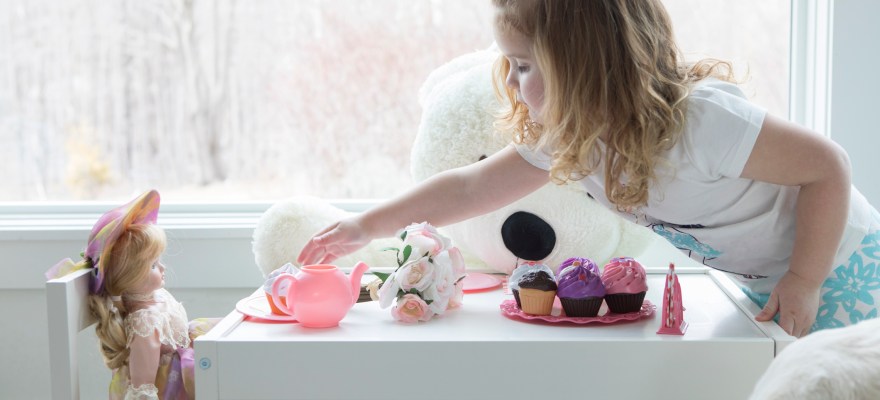
There’s more to playing with dolls than just fun. There are many ways doll play helps kids, and with the new Barbie movie coming out soon, what better time than now to shed light on the magical world of dolls and all that they offer?
Mattel, Inc.—the makers of Barbie herself—is no stranger to knowing how beneficial dolls are for kids. Last year, the doll maker, along with Cardiff University, released results of a multi-year study that showed children use increased language about others’ thoughts and emotions when playing alone with dolls.
“When children create imaginary worlds and role play with dolls, they communicate at first out loud and then internalize the message about others’ thoughts, emotions and feelings,” Cardiff researcher Dr. Sarah Gerson said. “This can have positive long-lasting effects on children, such as driving higher rates of social and emotional processing and building social skills like empathy that can become internalized to build and form lifelong habits.”
Experts also say it’s pretty important for parents to incorporate dolls into their child’s play routine.
“It’s integral for parents to incorporate dolls into their child’s play routine. Studies show that playing with dolls allows children to develop empathy and social processing skills,” Frances Cuomo Perpero, a mom of two and owner of Little Doll Studio, Rockville Centre, Long Island, said. “Doll play offers interactive, unstructured, imaginative exploration. It can be played alone, alongside, or together with others. It allows children to develop empathy and to think about other people and how they might interact with each other.”
Christine Hernandez, a certified doula, early childhood and parenting expert, and founder of Allo Saratoga, agreed and cited the book, “Bears, Bears Everywhere!” by psychotherapist and educator, Lesley Koplow, on this exact topic. The research in the book uses stuffed bears instead of dolls, but it’s a similar concept.
“Koplow cites research on attachment theory and advocates for stuffed animals or dolls in the classroom to help teachers of all age-groups learn coping strategies and develop emotional intelligence,” Hernandez said.
And here’s something interesting when it comes to the ways doll play helps kids: When playing with dolls, kids rehearse some of the social skills they will need later in life, including sharing, cooperation, helping others and problem-solving. They do this by assuming roles and shared interactions during play.
It also beats playing with screen-time gadgets, Cuomo Perpero said.
“In a digital, on-demand age, screen time can take away from traditional play time that is needed for children to enhance fine motor skills through such actions as doll dressing and manipulating playsets,” she said.
Playing with dolls offers so much when it comes to fostering and encouraging creativity, too.
“Dolls are a great example of an open-ended toy. There isn’t one ‘right way’ to play with a doll, and children are free to create their own storylines or roles for themselves and the doll,” Hernandez said. “A young toddler may just push the doll in a stroller, as they see their parent doing, but as the child ages their play will become more sophisticated. They’ll ascribe different roles and personalities to the doll as they learn to problem-solve and think outside the box. Maybe one day the doll is a student in their pretend classroom and the next day the doll is a patient at their pretend doctor’s office.”
Psst…Check out Mattel’s first-ever Barbie doll for preschoolers.
8 Ways Doll Play Helps Kids
Cuomo Perpero, who’s literally surrounded by dolls all day, shared some other doll-playing benefits. Doll playing helps with:
- ROLE-PLAYING: Doll playing gives children opportunities to try out different roles in a safe environment.
- COMFORT: Dolls bring comfort! Simply put, they bring the large world into a manageable size that children can reshape and have some control over. Let’s face it, kids often have very little control in their day to day lives. With doll play, it’s a fresh blank slate for the child every time they sit down to play, giving the child control of the narrative and the dialogue.
- LANGUAGE DEVELOPMENT: Playing with dolls fosters language development and encourages conversations.
- EMOTIONAL INTELLIGENCE: Helps work through emotions through dramatic play.
- BONDING: Brings parents and children closer through discussion and reflection.
- WORLDVIEW: Dolls can help children learn the different roles people play and how they see themselves in the world.
- IMAGINATION: And creativity, too. Dolls encourage children to create their own little imaginary worlds, giving them a vehicle to pretend to be anything, acting out different adventures.
- NEW: The ways doll play helps kids can include providing open-ended scenarios to be played with again and again in different ways.
Which Dolls are Popular Lately?
Barbie is considered to be one of the best selling toys of all time. She’s a classic and will likely remain on top, but other dolls are fun and popular, too.
“LOL Surprise dolls have increased in popularity due to the element of surprise in the unboxing,” Cuomo Perpero said. “At Little Doll Studio, we find that guests really love character dolls, such as Frozen, Encanto, Zombies, Descendants, all the Disney princesses, Harry Potter and the Marvel dolls. They get very excited when they see them. We just added the dolls from the new The Little Mermaid movie. That’s a very popular play set.”
Wanna read more stuff like this? Get our newsletters packed with ideas, events, and information for parents in Staten Island.






